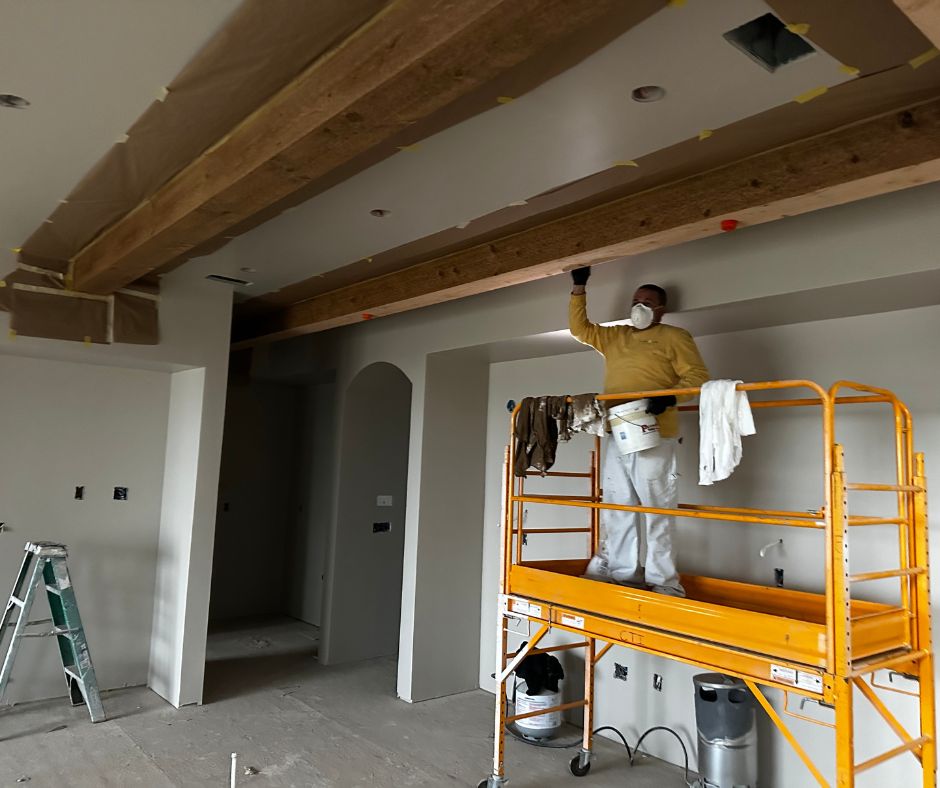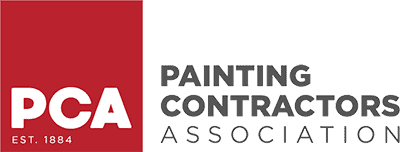When it comes to transforming the interior of your home, professional painters play a vital role in bringing your vision to life. These skilled artisans provide a wide range of services that ensure your space is not only visually appealing but also well-protected against everyday wear and tear. In this guide, we will delve into the various components of professional interior painting services, offering you valuable insights into what you can expect from these experts.
- ” value=”4″>Sanding: Carefully smoothing out rough spots or existing paint, creating a uniform texture.
By diligently executing these steps, professional painters achieve impeccable results on your painting project that leave surfaces looking flawless and your paint job beautiful.
Protecting and Masking Interior Painting Projects:
To prevent paint from splattering or dripping onto unintended surfaces, professional painters take meticulous precautions for an interior painting project, including:
a. Masking involves carefully taping off edges, trim, and other areas to achieve precise lines and protect surfaces such as baseboards and window frames.
b. Drop Cloths: Professional house painters will cover floors, furniture, and other objects in the room with protective coverings, effectively safeguarding them from any accidental paint spills or drips.
Paint Application:
Once the preparation work is complete, it’s time to apply a fresh coat of paint. Interior house painters use various techniques to ensure an even and smooth coat on interior walls and trim:
a. Brushing and Rolling: Using high-quality brushes and rollers to apply paint evenly to walls and ceilings.
b. Spraying: For large, flat surfaces like ceilings or in some cases, walls, professionals may use paint sprayers for a more uniform finish.
c. Multiple Coats: A professional house painter will apply multiple coats of paint as needed to achieve the desired depth and opacity.
Cleanup and Final Touches:
After the paint has dried, a professional painter will complete the job by:
a. Removing Masking and Drop Cloths: Carefully taking down protective materials and ensuring no residue is left behind.
b. Inspecting the Work: Conducting a final inspection to catch any imperfections and touch up as necessary.
c. Cleanup: Professional house painters will properly dispose of paint cans, brushes, and other materials, leaving your home clean and tidy.
Quality Assurance:
Professional painters take pride in their work and often offer guarantees or warranties on their services. They are committed to ensuring your satisfaction with the final result and will address any concerns or issues promptly.
Additional Services:
Beyond the core interior painting process, professional painters may also offer additional services, such as:
a. Wallpaper Installation or Removal: Helping you achieve a specific look or revamp your space by installing or removing wallpaper.
b. Trim and Molding Painting: Providing attention to detail by painting trim, crown molding, and baseboards to complement the walls.
c. Specialty Finishes: Offering specialized painting techniques like faux finishes or texture application to create unique effects.
Conclusion:
Professional interior house painting services encompass much more than just selecting the right color. From thorough surface preparation and protection to expert paint application and cleanup, these professionals ensure your home receives the highest quality treatment. Whether you’re refreshing a single room or undertaking a whole-home makeover, hiring a professional painter guarantees a stunning and lasting transformation for your interior spaces.
Frequently Asked Questions:
What is included in a professional interior house painting project?
A professional interior house painting project typically includes several components and considerations beyond labor and preparation. These additional aspects ensure that the painting job is completed effectively and to a high standard. Here are some key elements:
- ” value=”2″>Painting Supplies: Professional painters will need various supplies, including brushes, rollers, trays, drop cloths, painter’s tape, and paint sprayers if applicable.
- ” value=”6″>Cleanup and Waste Disposal: After the project is complete, the contractor should clean up the work area and properly dispose of any paint cans, used materials, and debris.
- ” value=”8″>Protection and Safety Measures: Professional painters should take safety precautions, such as wearing protective gear and ensuring proper ventilation during the painting process.
- ” value=”10″>Surface Repairs: In some cases, especially with older homes or walls in poor condition, additional repairs such as plastering or drywall replacement may be needed before interior painting.
It’s essential to have a detailed contract or agreement with your painting contractor that outlines all these aspects, including the scope of work for interior painting services, materials, costs, and any warranties or guarantees. This helps ensure transparency and a successful painting project.
What Do Most Painters Charge Hourly For Interior House Painting Services?
The hourly rate charged by painters can vary significantly depending on various factors, including location, experience, the complexity of the job, and the type of painting work involved. On average, as of my last knowledge update in September 2021, here’s a rough breakdown of what you might expect to pay:
- ” value=”2″>Experienced painters: Experienced painters often charge between $35 and $50 per hour. They have a track record of quality work and can handle a wider range of projects.
- ” value=”4″>High-demand or premium painters: In areas with a high cost of living or where painters have a strong reputation, rates can go significantly higher. Some premium painters may charge $75 or more per hour.
Remember that these are general guidelines, and actual rates can vary widely. Additionally, many painters may prefer to offer a fixed project cost rather than hourly rates, especially for larger or more complex jobs. Fixed pricing can provide more clarity and peace of mind for both the painter and the client.
It’s essential to obtain multiple quotes from painters in your area to get a better sense of the prevailing rates for your specific project. Keep in mind that factors like the cost of materials, the size and condition of the surface to be painted, and any necessary preparation work will also influence the overall cost of a painting project.
What Is The Best Paint For Interior Walls and Trim?
Choosing the right interior paint for your home’s interior not only enhances its aesthetic appeal, but also protects your walls and ceilings, contributes to better indoor air quality, and adds to the overall value of your property.
Opting for premium wall paints such as Sherwin Williams Super Paint or Benjamin Moore’s Ben provides a multitude of benefits, notably their ease of maintenance and superior overall performance. Such high-quality paints are renowned for their exceptional durability, providing a finish that is resistant to wear and tear, fading, and staining. This means fewer touch-ups and long-term cost savings. Additionally, they offer superior coverage, often requiring fewer coats to achieve the desired look. They are also easier to clean, a beneficial feature especially in high-traffic areas or homes with children or pets. The investment in premium paints ultimately results in a beautiful, long-lasting finish that enhances the aesthetics and value of your home.
For more information about interior house painting services, check out our guide to interior house painting.


